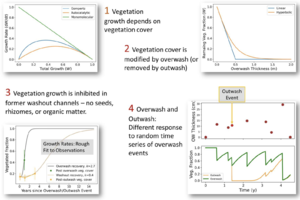2024 CSDMS meeting-088
From CSDMS
(if you haven't already)
"MA" is not in the list (NO STATE, Alabama, Alaska, Arizona, Arkansas, California, Colorado, Connecticut, D.C., Delaware, ...) of allowed values for the "CSDMS meeting state" property.
Log in (or create account for non-CSDMS members)
Forgot username? Search or email:CSDMSweb@colorado.edu
Browse abstracts
Conceptual Model for Revegetation of Barrier Islands after Outwash and Overwash Events
Chris Sherwood,
(he/him),US Geological Survey Woods Hole , United States. csherwood@usgs.gov
Jin-Si Over, US Geological Survey Woods Hole Massachusetts, United States. jover@usgs.gov
There is growing recognition that outwash events are potent agents of morphological change in some coastal regions. Outwash associated with inundation from the back side (bay, lagoon, sound, or marsh) occurred during Hurricane Harvey in Texas (2017) and Hurricane Dorian in North Carolina (2019). In both cases, floodwaters crossed the barrier islands and drained to the ocean through gaps in the primary dune lines, incising deep (~2-m) channels 30- 100-m wide in the islands and depositing the sand in the ocean. In both cases, partial recovery occurred within days and months as nearshore and beach processes generated spits, bars, berms, and overwash fans that rebuilt the beach and closed the channels, creating a series of ponds. Normally, washover deposits are quickly (1 – 2 years) revegetated with beach grasses that trap wind-driven sand and initiate dune building. However, in Texas, North Carolina, and several other locations where outwash channels were observed, the channels have remained largely unvegetated and no dunes have appeared. We have adapted a simple conceptual model to account for these observations. The model argues that the rate of vegetation growth depends, at least partially, on the amount of vegetation already present. In the case of overwash, material is deposited on older washover fans or platforms that contain live plants, seeds, rhizomes, and other organic material, and (following others) we suggest that the amount of vegetative material is a function of washover-deposit thickness. In contrast, when washout channels are filled, none of that material is present, and our model assigns these deposits very low initial amounts of vegetative material. Thus, vegetation growth on the two landscapes occurs at different rates, and the former outwash channels are unable to build elevation as quickly, leaving them continuously exposed to overwash events. A quantitative implementation of this model provides results that match well with observations at several sites.

